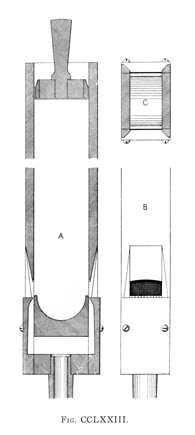

|
Doppelflöt[e] German Double Flute English |
Flute Double English |
|
Doiflöt Dutch Doiflöte German Duiflöt Dutch |
Duiflöte German Flöte dupla German/Latin Flûte dupla French/Latin |

The Doppelflöte is a wooden stop with two mouths, located on opposite sides of the pipe. It is nearly always found at 8' pitch. Authorities disagree on whether it is open or stopped, and Grove reports that it sometimes has bored stoppers (see Doppelrohrflöte). The stopped construction seems to be the more common, particularly in the 1800's.
The earliest reference to this pipe form is found in the second volume of Praetorius's Syntagma Musicum. Therein the author credits Esaias Compenius with having invented it around 1590 as a covered stop of 4' pitch, calling it Duifloete. Praetorius remarks that it had not yet become popular.
According to Williams, the Doppelflöte was frequently found in Silesia (southwest Poland and northern Czechoslovakia) from the 1600's through the 1800's. It was never popular in England, but in America was a favorite of the Roosevelt firm. Its tone has been described as full, strong, pure, round, and liquid. Some sources criticize it as being hooting. It is chiefly a solo stop; Audsley considers it a good blender, but Skinner disagrees. Because of its two mouths, the Doppelflöte requires more than the usual amount of space on the wind chest.The photograph (courtesy of John Gouwens) shows a Doppelflöte pipe in front of a mirror, clearly showing the two mouths. Click on it for a larger image.
The double-mouth construction is usually abandoned in the 8' octave in favor of a normal single-mouth construction. Audsley provides the illustration reproduced here, with the following description:
From tenor C to the top, each pipe has two mouths, placed on the opposite and narrower sides of a block in which a semicircular depression has been cut, leaving two thin lower lips to the mouths. The mouths and caps are of the English form, the lower lips being somewhat widely nicked, and the upper lips arched and carefully formed and rounded. In the Drawing 1, is given a Longitudinal Section of a pipe, cut through the mouths, at A, and showing the forms of the block, cap and wind-ways. Above, at B, is given a ection of the stopper, edged with cork and covered with soft leather. A Front View of one of the mouths is given in Drawing 2, showing its height, the arching of the upper lip, the nicking of the lower lip, and the lateral splays. In the Drawing 3 is given a Transverse Section through the mouths, showing the depression in the block, the lower nicked lips, the windways, and the upper edges of the caps. All the parts are drawn in correct proportion and to scale.
Bonavia-Hunt recommends a scale of 2 1/8" x 1 3/8" at middle C. Audsley provides Roosevelt's standard scale as follows, noting that it is an irregular one:
| Tenor C | middle c1 | c2 | |
|---|---|---|---|
| width | 2 1/4" | 1 3/8" | 3/4" |
| depth | 3 7/16" | 2 3/16" | 1 7/16" |
The name Flute Double is mentioned only by Wedgwood in his entry for Major Flute, without any definition. Osiris contains two examples, both at 8' pitch, suggesting that they may be synonyms for Doppelflöte. Duiflöt may also be a synonym for Sifflöte.
|
Bifara - a single-rank celeste Doppelgedeckt Doppelflötenbass Doppelrohrbordun Doppelrohrflöte Doppelrohrgedeckt |
Doppelspitzflöte Flauto Primo Jubalflöte Ludwigtone - a single-rank celeste Philomela Seraphonflöte - two mouths on adjacent sides |
Osiris contains 37 examples of Doppelflöte at 8' pitch, and one example at 2' pitch. No examples are known of Doiflöt, Doiflöte, Duiflöte, Flöte dupla or Flûte dupla. Contributions welcome. All known examples of the other names are given below.
Flöte dupla 8', Oberwerk; Stadtkirche, Waltershausen, Germany; Trost 1724. This is the early known example of this name, but it is not known whether it was a true Doppelflöte or a two-rank stop like the Bifara.
Doppelflöte 8', Hauptwerk; Merseburg Cathedral, Merseburg, Germany; Ladegast 1853-55. This is the early known example of this name.
Doppelflöte 8', Great; Culver Academies, Indiana, USA. (See below for sound clips.)
Duiflöt 4', Zweites Clavier; Stadtkirche, Nieder-Moos, Germany; Oestreich 1791.
Flute Double 8', Recit; St. Marzellinus & Petrus, Vallendar, Germany; Oberlinger 1998.
Flute Double 8', Solo; Broadway Baptist Church, Fort Worth, Texas, USA; Casavant 1996.
Double Flute 8', Great, Swell, Ethereal, Orchestral; John Wanamaker Store, Philadelphia, Pennsylvania, USA.
Double Flute 8', Great; John Wanamaker Store, New York City, New York, USA; 1920.
See the Sound Files appendix for general information.
| Doppelflöte 8', Great | Culver Academies, Indiana, USA | Fabry 2007-08; from Wm. King & Son c.1890 | arpeggio | St. Anne | St. Anne (solo) |
|
Copyright © 1999, 2010 Edward L. Stauff, all rights reserved. Doppelflote.html - Last updated 20 February 2010. |
Home Full Index |